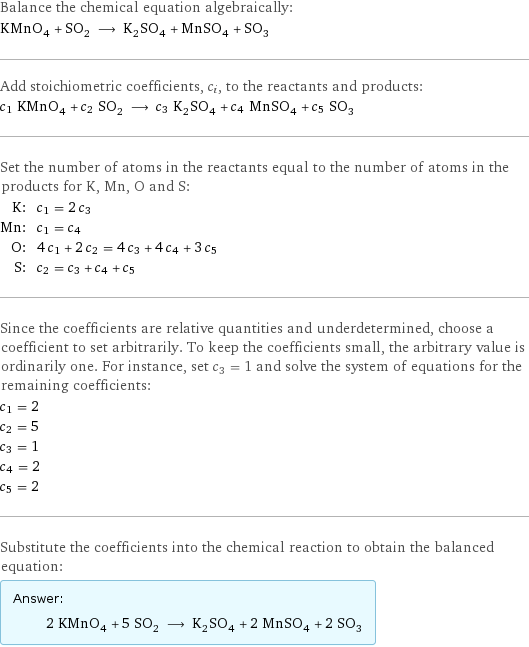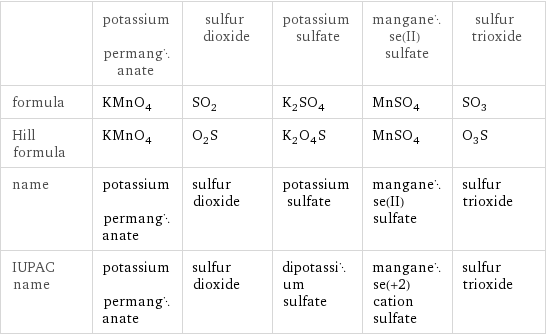Input interpretation

KMnO_4 potassium permanganate + SO_2 sulfur dioxide ⟶ K_2SO_4 potassium sulfate + MnSO_4 manganese(II) sulfate + SO_3 sulfur trioxide
Balanced equation

Balance the chemical equation algebraically: KMnO_4 + SO_2 ⟶ K_2SO_4 + MnSO_4 + SO_3 Add stoichiometric coefficients, c_i, to the reactants and products: c_1 KMnO_4 + c_2 SO_2 ⟶ c_3 K_2SO_4 + c_4 MnSO_4 + c_5 SO_3 Set the number of atoms in the reactants equal to the number of atoms in the products for K, Mn, O and S: K: | c_1 = 2 c_3 Mn: | c_1 = c_4 O: | 4 c_1 + 2 c_2 = 4 c_3 + 4 c_4 + 3 c_5 S: | c_2 = c_3 + c_4 + c_5 Since the coefficients are relative quantities and underdetermined, choose a coefficient to set arbitrarily. To keep the coefficients small, the arbitrary value is ordinarily one. For instance, set c_3 = 1 and solve the system of equations for the remaining coefficients: c_1 = 2 c_2 = 5 c_3 = 1 c_4 = 2 c_5 = 2 Substitute the coefficients into the chemical reaction to obtain the balanced equation: Answer: | | 2 KMnO_4 + 5 SO_2 ⟶ K_2SO_4 + 2 MnSO_4 + 2 SO_3
Structures

+ ⟶ + +
Names

potassium permanganate + sulfur dioxide ⟶ potassium sulfate + manganese(II) sulfate + sulfur trioxide
Equilibrium constant
![Construct the equilibrium constant, K, expression for: KMnO_4 + SO_2 ⟶ K_2SO_4 + MnSO_4 + SO_3 Plan: • Balance the chemical equation. • Determine the stoichiometric numbers. • Assemble the activity expression for each chemical species. • Use the activity expressions to build the equilibrium constant expression. Write the balanced chemical equation: 2 KMnO_4 + 5 SO_2 ⟶ K_2SO_4 + 2 MnSO_4 + 2 SO_3 Assign stoichiometric numbers, ν_i, using the stoichiometric coefficients, c_i, from the balanced chemical equation in the following manner: ν_i = -c_i for reactants and ν_i = c_i for products: chemical species | c_i | ν_i KMnO_4 | 2 | -2 SO_2 | 5 | -5 K_2SO_4 | 1 | 1 MnSO_4 | 2 | 2 SO_3 | 2 | 2 Assemble the activity expressions accounting for the state of matter and ν_i: chemical species | c_i | ν_i | activity expression KMnO_4 | 2 | -2 | ([KMnO4])^(-2) SO_2 | 5 | -5 | ([SO2])^(-5) K_2SO_4 | 1 | 1 | [K2SO4] MnSO_4 | 2 | 2 | ([MnSO4])^2 SO_3 | 2 | 2 | ([SO3])^2 The equilibrium constant symbol in the concentration basis is: K_c Mulitply the activity expressions to arrive at the K_c expression: Answer: | | K_c = ([KMnO4])^(-2) ([SO2])^(-5) [K2SO4] ([MnSO4])^2 ([SO3])^2 = ([K2SO4] ([MnSO4])^2 ([SO3])^2)/(([KMnO4])^2 ([SO2])^5)](../image_source/1584eceb05378025a8707871e7c7fc07.png)
Construct the equilibrium constant, K, expression for: KMnO_4 + SO_2 ⟶ K_2SO_4 + MnSO_4 + SO_3 Plan: • Balance the chemical equation. • Determine the stoichiometric numbers. • Assemble the activity expression for each chemical species. • Use the activity expressions to build the equilibrium constant expression. Write the balanced chemical equation: 2 KMnO_4 + 5 SO_2 ⟶ K_2SO_4 + 2 MnSO_4 + 2 SO_3 Assign stoichiometric numbers, ν_i, using the stoichiometric coefficients, c_i, from the balanced chemical equation in the following manner: ν_i = -c_i for reactants and ν_i = c_i for products: chemical species | c_i | ν_i KMnO_4 | 2 | -2 SO_2 | 5 | -5 K_2SO_4 | 1 | 1 MnSO_4 | 2 | 2 SO_3 | 2 | 2 Assemble the activity expressions accounting for the state of matter and ν_i: chemical species | c_i | ν_i | activity expression KMnO_4 | 2 | -2 | ([KMnO4])^(-2) SO_2 | 5 | -5 | ([SO2])^(-5) K_2SO_4 | 1 | 1 | [K2SO4] MnSO_4 | 2 | 2 | ([MnSO4])^2 SO_3 | 2 | 2 | ([SO3])^2 The equilibrium constant symbol in the concentration basis is: K_c Mulitply the activity expressions to arrive at the K_c expression: Answer: | | K_c = ([KMnO4])^(-2) ([SO2])^(-5) [K2SO4] ([MnSO4])^2 ([SO3])^2 = ([K2SO4] ([MnSO4])^2 ([SO3])^2)/(([KMnO4])^2 ([SO2])^5)
Rate of reaction
![Construct the rate of reaction expression for: KMnO_4 + SO_2 ⟶ K_2SO_4 + MnSO_4 + SO_3 Plan: • Balance the chemical equation. • Determine the stoichiometric numbers. • Assemble the rate term for each chemical species. • Write the rate of reaction expression. Write the balanced chemical equation: 2 KMnO_4 + 5 SO_2 ⟶ K_2SO_4 + 2 MnSO_4 + 2 SO_3 Assign stoichiometric numbers, ν_i, using the stoichiometric coefficients, c_i, from the balanced chemical equation in the following manner: ν_i = -c_i for reactants and ν_i = c_i for products: chemical species | c_i | ν_i KMnO_4 | 2 | -2 SO_2 | 5 | -5 K_2SO_4 | 1 | 1 MnSO_4 | 2 | 2 SO_3 | 2 | 2 The rate term for each chemical species, B_i, is 1/ν_i(Δ[B_i])/(Δt) where [B_i] is the amount concentration and t is time: chemical species | c_i | ν_i | rate term KMnO_4 | 2 | -2 | -1/2 (Δ[KMnO4])/(Δt) SO_2 | 5 | -5 | -1/5 (Δ[SO2])/(Δt) K_2SO_4 | 1 | 1 | (Δ[K2SO4])/(Δt) MnSO_4 | 2 | 2 | 1/2 (Δ[MnSO4])/(Δt) SO_3 | 2 | 2 | 1/2 (Δ[SO3])/(Δt) (for infinitesimal rate of change, replace Δ with d) Set the rate terms equal to each other to arrive at the rate expression: Answer: | | rate = -1/2 (Δ[KMnO4])/(Δt) = -1/5 (Δ[SO2])/(Δt) = (Δ[K2SO4])/(Δt) = 1/2 (Δ[MnSO4])/(Δt) = 1/2 (Δ[SO3])/(Δt) (assuming constant volume and no accumulation of intermediates or side products)](../image_source/7c46a3e442bfe400f56efcf525a9e253.png)
Construct the rate of reaction expression for: KMnO_4 + SO_2 ⟶ K_2SO_4 + MnSO_4 + SO_3 Plan: • Balance the chemical equation. • Determine the stoichiometric numbers. • Assemble the rate term for each chemical species. • Write the rate of reaction expression. Write the balanced chemical equation: 2 KMnO_4 + 5 SO_2 ⟶ K_2SO_4 + 2 MnSO_4 + 2 SO_3 Assign stoichiometric numbers, ν_i, using the stoichiometric coefficients, c_i, from the balanced chemical equation in the following manner: ν_i = -c_i for reactants and ν_i = c_i for products: chemical species | c_i | ν_i KMnO_4 | 2 | -2 SO_2 | 5 | -5 K_2SO_4 | 1 | 1 MnSO_4 | 2 | 2 SO_3 | 2 | 2 The rate term for each chemical species, B_i, is 1/ν_i(Δ[B_i])/(Δt) where [B_i] is the amount concentration and t is time: chemical species | c_i | ν_i | rate term KMnO_4 | 2 | -2 | -1/2 (Δ[KMnO4])/(Δt) SO_2 | 5 | -5 | -1/5 (Δ[SO2])/(Δt) K_2SO_4 | 1 | 1 | (Δ[K2SO4])/(Δt) MnSO_4 | 2 | 2 | 1/2 (Δ[MnSO4])/(Δt) SO_3 | 2 | 2 | 1/2 (Δ[SO3])/(Δt) (for infinitesimal rate of change, replace Δ with d) Set the rate terms equal to each other to arrive at the rate expression: Answer: | | rate = -1/2 (Δ[KMnO4])/(Δt) = -1/5 (Δ[SO2])/(Δt) = (Δ[K2SO4])/(Δt) = 1/2 (Δ[MnSO4])/(Δt) = 1/2 (Δ[SO3])/(Δt) (assuming constant volume and no accumulation of intermediates or side products)
Chemical names and formulas

| potassium permanganate | sulfur dioxide | potassium sulfate | manganese(II) sulfate | sulfur trioxide formula | KMnO_4 | SO_2 | K_2SO_4 | MnSO_4 | SO_3 Hill formula | KMnO_4 | O_2S | K_2O_4S | MnSO_4 | O_3S name | potassium permanganate | sulfur dioxide | potassium sulfate | manganese(II) sulfate | sulfur trioxide IUPAC name | potassium permanganate | sulfur dioxide | dipotassium sulfate | manganese(+2) cation sulfate | sulfur trioxide
Substance properties

| potassium permanganate | sulfur dioxide | potassium sulfate | manganese(II) sulfate | sulfur trioxide molar mass | 158.03 g/mol | 64.06 g/mol | 174.25 g/mol | 150.99 g/mol | 80.06 g/mol phase | solid (at STP) | gas (at STP) | | solid (at STP) | liquid (at STP) melting point | 240 °C | -73 °C | | 710 °C | 16.8 °C boiling point | | -10 °C | | | 44.7 °C density | 1 g/cm^3 | 0.002619 g/cm^3 (at 25 °C) | | 3.25 g/cm^3 | 1.97 g/cm^3 solubility in water | | | soluble | soluble | reacts surface tension | | 0.02859 N/m | | | dynamic viscosity | | 1.282×10^-5 Pa s (at 25 °C) | | | 0.00159 Pa s (at 30 °C) odor | odorless | | | |
Units
